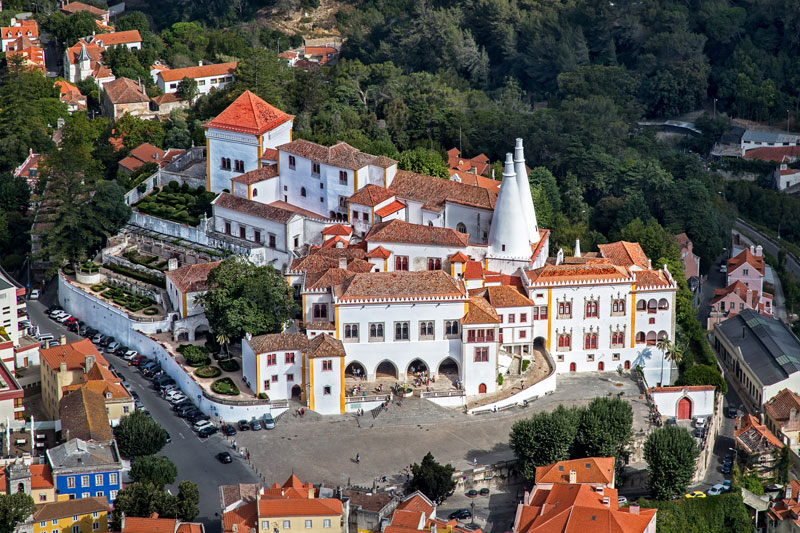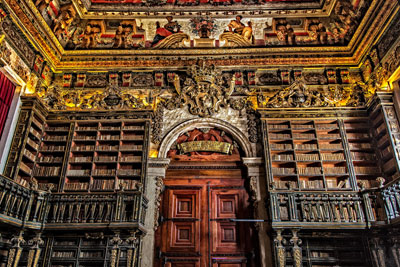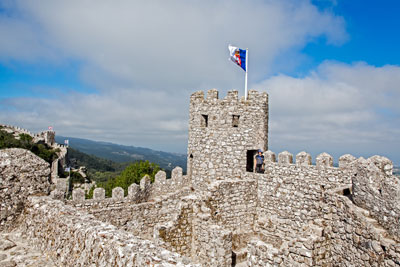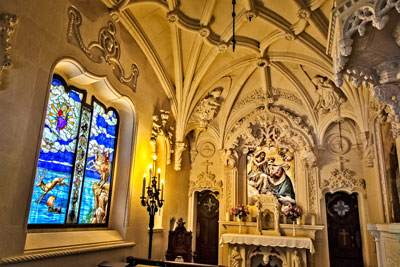Churches, castles and cafés abound on a private tour of Portugal
This article appears on page 34 of the April 2015 issue.
The trip to Portugal that my wife, Yuki, and I took in August 2014 might not have been as exotic as some of our past vacations, but we met some really nice folks and ate some interesting food.
An overview
The highlights for us included the country’s many castles and churches, some 500 to 1,000 years old — so interesting and photogenic!
And the food? We enjoyed ham for breakfast, lunch and, yes, dinner, and the wild boar was superb. I found more varieties of salami and ham than I ever knew existed! Yuki enjoyed the sardines (a local specialty) and octopus (also famous), and the breakfast buffets were extensive and tasty.
Our accommodations included some excellent hotels and pousadas, hotels created in historical properties such as former castles. (There were a few good ones and a few to avoid at all costs.)
One of the best parts of the trip was stopping for lunch at “no name” cafés along the main thoroughfares. We’d order a freshly baked roll, crispy on the outside, soft and tasty on the inside, with ham and cheese and, sure, why not, a glass of homemade wine.
Occasionally, we’d find local specialties, like Pão-de-Ló, a sponge cake with a soft, chewy, cinnamon-laden interior.
As most travelers know, what really makes a trip are the folks one meets. Through an extraordinary bit of good luck, we were gifted with Francisco Ornelas (contact c/o ITN), our driver, who soon became a friend.
An excellent driver, he is an intelligent polyglot who was kind enough to laugh at my jokes. He truly made an “OK” trip superb.
And there were lots of nice little old ladies who were happy to chitchat with us.
Our car was similarly excellent. It was a brand-new, shiny black 400-series Mercedes that had real buttons to change the temperature and fan speed! We didn’t have to take a course in “Mercedes Computer 101” to operate it, and it was quiet — very nice.
We couldn’t get frequent-flyer tickets for our flight to Portugal, so we found the most economical route, flying with American Airlines from San Diego to Dallas to London to Lisbon. On the return, we were able to fly from Lisbon to London, then directly from London to San Diego.
Dining out
Our first hotel was the Bairro Alto Hotel, which was centrally located — just perfect, actually — with a superb staff, but our room was very dark. When I inquired, I was told it was for “ambiance.” Take a reading light and a flashlight.
There were a bunch of superb hole-in-the-wall restaurants within a few minutes’ walk from the hotel. We had dinner at Restaurante Cabaças (Rua das Gáveas, 8-10), where my pork was quite good and Yuki loved her octopus risotto.
The next night we supped at Floresta da Cidade, which turned out to be quite good. We shared soup and Yuki had sardines, while I had some kind of pork.
Of course, we had to visit the Amorino ice cream parlor, which I highly recommend, especially if you’re a chocoholic like I am.
On another evening, after we had walked a lot, my wife actually allowed me to eat a scrumptious Amorino waffle with rich, dark chocolate ice cream drenched in chocolate syrup, with a hot chocolate drink for dinner!
Note: The “snacks” (olives, bread, salami, etc.) you find when you sit down at your dinner table are not free! If you touch them, you will be charged for them. Do check your bill to make sure you haven’t been charged for unordered items; it’s rare but does happen.
Most of our lunches averaged $10 per person and our dinners, $25 each.
Grand architecture
Lisbon is a great city for walking. After first visiting two viewpoints, Miradouro da Graça and Miradouro da Nossa Senhora do Monte, we walked through several flea markets, including Feira da Ladra, where all sorts of junk was for sale. We then entered the 17th-century Igreja de Santa Engrácia chuch, featuring lovely domed ceilings, and, after walking up four flights of stairs, we found some nice views of both the inside of the church and Lisbon.
Strolling through the older Alfama section was also picturesque, and soon we were at Igreja de São Domingos. Not fully restored after a fire, it had fascinating blackened walls, with a modern altar.
We visited the famous National Palace of Sintra, but, as we’re not fans of wandering through palaces, we just took some pictures of the outside.
We did enjoy visiting the Castle of the Moors (a good spot for taking pictures of the palace), but we somehow lost our way as we tried to return to the parking lot.
We found almost all Portuguese tourist spots to be absolutely bereft of any helpful signs on how to get anywhere, especially back to the entrance, so I’d recommend taking a local map and making notes as you walk around. We had to call Francisco and he somehow managed to find us.
After visiting the grounds of Sintra’s Pena Palace and the Regaleira Estate, we were both a bit peckish, so we asked a nice lady who was standing in a nearby parking lot about a good restaurant. She strongly recommended Ribeirinha de Colares (Avenida dos Bombeiros Voluntários 71), oddly enough in the city of Colares, and the food was truly superb. Yuki had a codfish pastry — “extremely tasty” was her judgment — and my salmon was excellent. Highly recommended!
Perusing posadas
After an easy 2-hour ride to Évora (the superhighways are excellent and not at all crowded) we visited the university there, which we did not find memorable, then continued to the walled city of Monsaraz, which dates back to prehistoric times.
Our next accommodation was a converted nunnery, Convento do Espinheiro, and much of the original church was still attached to the convent. Our welcome drink was some kind of alcoholic herbal beverage called Licor de Poejo, which was quite tasty.
After spending some time in the steam room (no charge), we went for dinner in the hotel. My pork and Yuki’s various fishy products were very tasty, but $7.50 for a bottle of sparkling water was a bit much.
We then drove to Arraiolos, a “typical” Alentejo village, noted for its white houses with blue accents as well as for the production of carpets. Unfortunately, almost all of the shops selling carpets were closed, and the carpets that I did see were of a distinctive pattern that was not much to my liking.
After a brief stop in Estremoz, we visited a pousada in Marvão where one could see Spain from its windows. Our hotel was in another pousada, Pousada do Crato, Flora da Rosa. It had a great design, with a nice mixture of old stone and smooth, white plaster walls, many of the stones clearly having been recycled from the original building; you could still see the holes once used for support beams and locks. There was a nice, museum-like area where there were old statues of Mary and Jesus to admire.
However, the staff spoke little to no English, the Internet was difficult to use, the pool was not user-friendly and we had a terrible time trying to unlock our door in the morning. It was a good place to visit, but I would not stay there again.
However, our next pousada, the Convento de Belmonte, had not only a superb staff but a 5-star restaurant! We started with a sampler of cheese, olive paste and olive oil, which I ate too much of because it was so good, so I had trouble finishing my wild boar, but it was so tasty that I just kept eating.
Yuki had pork osso buco (or the equivalent) and it disappeared quite quickly. They were even kind enough to bring a very tasty chocolate cake, with a candle, to celebrate Yuki’s birthday. Chef Valdir Lubave is to be commended!
The only somewhat strange element of our stay there was that, while we could turn the air-conditioning on and off in our room, we had to call the front desk to change the temperature, but they did it within seconds when asked.
On to Porto
Soon it was time to head out to Porto, a center for Portugal’s famous port wine. Francisco, who had studied in Porto, expertly drove us around before letting us off at the Pousada do Porto, Freixo Palace Hotel, located directly opposite some abandoned silos from a long-absent factory.
The Freixo Palace pousada, itself, contains just the reception area, a bar and a restaurant; the guest rooms are located in a new building. Our room was just perfect, offering a river view, quiet air-conditioning, spotlights over each side of the bed for reading and plenty of hot water.
That evening we were off to dinner with Francisco at one of his favorite restaurants, Capa Negra II, on Rua Campo Alegre. It was inexpensive (dishes averaged €10-€14) and delicious. Lines form quickly, so go early!
While in Porto, we elected not to visit wineries and didn’t take the typical Douro River cruise, but we did take a few photos at the Guimarães Castle (1,000 years old) and visited the Igreja de Nossa Senhora da Oliveira (Church of our Lady of the Olive Branch).
The next day we quickly visited Braga and soon afterward were in Barcelos, where there was a super outdoor market. It was fun walking around and seeing what was for sale.
We stopped briefly in Ponte de Lima, which had a bridge from Roman times, and were surprised at how many folks were gathered at the riverside, swimming, boating and just soaking up some rays.
A few final stops
Next on our itinerary was Coimbra, famous for its university specializing in law and medicine, established in 1290. The library there was reportedly the model for the one in the Harry Potter movies, and it’s stupendous, with old wooden shelves and leather-bound books from floor to ceiling. Adorned with sumptuous paintings and carvings, it’s a “must see”! (Photos are not permitted without prior arrangement.)
The town’s cathedral, Sé Velha de Coimbra, was also well worth a visit.
Our hotel, the Areias do Seixo beachside resort hotel, stresses that it is “natural,” and they grow most of the veggies they serve. The hotel was truly lovely, but it was not my kind of place. We did not care for the bare concrete-block ceilings and glass floors or the poor Internet connection.
Dinner was served in a room filled with incense, and the pitcher of tap water we ordered cost $5, the veggie risotto, $32.
I wouldn’t stay there again.
Our final stay was back in Lisbon at the Myriad by SANA Hotels, whose sail-like shape called to mind the Burj Al Arab Jumeirah in Dubai. The service was the best we had encountered, the food at the restaurant was tasty, the room had an untrammeled view of the Vasco da Gama Bridge and excellent free snacks and a coffeemaker in the room, and it was close to the airport. I highly recommend it!
Our 2-week custom tour from Tours For You (Lisbon, Portugal; phone +351 21 390 42 08, www.toursforyou.pt), including all accommodations, tours, driver and private transfers, cost E5,580 ($6,322) per person, double.
All in all, it was a fun trip, and perhaps the best part was spending time with Francisco. He’s become a good friend. We’d suggest contacting him directly if you are planning a visit to Portugal.





